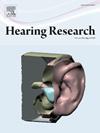Critical role of hepsin/TMPRSS1 in hearing and tectorial membrane morphogenesis: Insights from transgenic mouse models
IF 2.5
2区 医学
Q1 AUDIOLOGY & SPEECH-LANGUAGE PATHOLOGY
引用次数: 0
Abstract
Mutations in various type II transmembrane serine protease (TMPRSS) family members are associated with non-syndromic hearing loss, with some mechanisms still unclear. For instance, the mechanism underlying profound hearing loss and tectorial membrane (TM) malformations in hepsin/TMPRSS1 knockout (KO) mice remains elusive. In this study, we confirmed significantly elevated hearing thresholds and abnormal TM morphology in hepsin KO mice, characterized by enlarged TM with gaps and detachment from the spiral limbus. Transgenic mouse lines were created to express either wild-type or a serine protease-dead mutant of human hepsin in the KO background. The Tg68;KO line, expressing moderate levels of wild-type human hepsin in the cochlea, showed partial restoration of hearing function. Conversely, the Tg5;KO or TgRS;KO lines, with undetectable hepsin or protease-dead hepsin, did not show such improvement. Histological analyses revealed that Tg68;KO mice, but not Tg5;KO or TgRS;KO mice, had a more compact TM structure, partially attached to the spiral limbus. These results indicate that hepsin expression levels correlate with improvements in hearing and TM morphology, and its protease activity is critical for these effects. Hepsin's role was further examined by studying its relationship with α-tectorin (TECTA) and β-tectorin (TECTB), non-collagenous proteins crucial for TM formation. Hepsin was co-expressed with TECTA and TECTB in the developing cochlear epithelium. Immunostaining showed decreased levels of TECTA and TECTB in hepsin KO TM, partially restored in Tg68;KO mice. These findings suggest that hepsin is essential for proper TM morphogenesis and auditory function, potentially by proteolytic processing/maturation of TECTA and TECTB and their incorporation into the TM.
hepsin/TMPRSS1在听力和胸膜形态发生中的关键作用:转基因小鼠模型的启示
各种 II 型跨膜丝氨酸蛋白酶(TMPRSS)家族成员的突变与非综合征性听力损失有关,其中一些机制仍不清楚。例如,hepsin/TMPRSS1基因敲除(KO)小鼠的深度听力损失和胸膜(TM)畸形的机制仍然不明。在这项研究中,我们证实了hepsin KO小鼠的听阈显著升高和TM形态异常,其特征是TM增大,有间隙并与螺旋缘分离。我们创建了转基因小鼠品系,在 KO 背景下表达野生型或丝氨酸蛋白酶致死突变体的人类嗜血蛋白。Tg68;KO品系在耳蜗中表达中等水平的野生型人类嗜血蛋白,听觉功能得到部分恢复。相反,Tg5;KO 或 TgRS;KO 株系中检测不到嗜肝素或嗜肝素蛋白酶死亡,听力功能没有得到改善。组织学分析表明,Tg68;KO 小鼠(而非 Tg5;KO 或 TgRS;KO 小鼠)的 TM 结构更紧凑,部分附着于螺旋缘。这些结果表明,肝素的表达水平与听力和 TM 形态的改善相关,而肝素的蛋白酶活性对这些效果至关重要。通过研究赫普新与α-蝶呤蛋白(TECTA)和β-蝶呤蛋白(TECTB)的关系,进一步考察了赫普新的作用。在发育中的耳蜗上皮细胞中,Hepsin与TECTA和TECTB共同表达。免疫染色显示,在hepsin KO TM中,TECTA和TECTB的水平下降,而在Tg68;KO小鼠中则部分恢复。这些研究结果表明,hepsin 对正常的 TM 形态发生和听觉功能至关重要,可能是通过对 TECTA 和 TECTB 进行蛋白水解处理/熟化,并将其纳入 TM。
本文章由计算机程序翻译,如有差异,请以英文原文为准。
求助全文
约1分钟内获得全文
求助全文
来源期刊

Hearing Research
医学-耳鼻喉科学
CiteScore
5.30
自引率
14.30%
发文量
163
审稿时长
75 days
期刊介绍:
The aim of the journal is to provide a forum for papers concerned with basic peripheral and central auditory mechanisms. Emphasis is on experimental and clinical studies, but theoretical and methodological papers will also be considered. The journal publishes original research papers, review and mini- review articles, rapid communications, method/protocol and perspective articles.
Papers submitted should deal with auditory anatomy, physiology, psychophysics, imaging, modeling and behavioural studies in animals and humans, as well as hearing aids and cochlear implants. Papers dealing with the vestibular system are also considered for publication. Papers on comparative aspects of hearing and on effects of drugs and environmental contaminants on hearing function will also be considered. Clinical papers will be accepted when they contribute to the understanding of normal and pathological hearing functions.
 求助内容:
求助内容: 应助结果提醒方式:
应助结果提醒方式:


